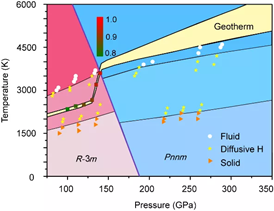Jurong Zhang,1, 2 Hanyu Liu,1, 3, * Yanming Ma,1, 3, * and Changfeng Chen4, *
1International Center for Computational Method and Software & State Key Laboratory of Superhard Materials & Key Laboratory of Physics and Technology for Advanced Batteries (Ministry of Education), College of Physics, Jilin University, Changchun 130012, China
2Shandong Provincial Engineering and Technical Center of Light Manipulations & Shandong Provincial Key Laboratory of Optics and Photonic Device, School of Physics and Electronics, Shandong Normal University, Jinan 250358, China
3International Center of Future Science, Jilin University, Changchun 130012, China
4Department of Physics and Astronomy, University of Nevada, Las Vegas,NV 89154,USA
Hydrogen and helium were known to play crucial roles in geological and astrophysical environments; however, they are inert toward each other across wide pressure-temperature (P-T). Given their prominent presence and influence on the formation and evolution of celestial bodies, it is of fundamental interest to explore the nature of interactions between hydrogen and helium. Using an advanced crystal structure search method, we have identified a quaternary compound FeO2H2He stabilized in a wide range of P-T conditions. Ab initio molecular dynamics simulations further reveal a novel superionic state of FeO2H2He hosting liquid-like diffusive hydrogen in the FeO2He sublattice, creating a conducive environment for H-He chemical association, at P-T conditions corresponding to the Earth's lowest mantle regions. This surprising chemically facilitated coalescence of otherwise immiscible molecular species highlights a promising avenue for exploring this long-sought but hitherto unattainable state of matter. This finding raises strong prospects for exotic H-He mixtures inside Earth and possibly also in other astronomical bodies.

Figure 1. Pressure-temperature phase diagram of FeO2H2He determined by Gibbs free energy from first-principles calculations and mean-square atomic displacements from AIMD simulations.
Related link:https://doi.org/10.1093/nsr/nwab168